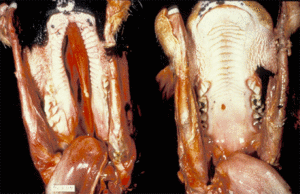Difference between revisions of "Cleft Palate"
| Line 11: | Line 11: | ||
==Description== | ==Description== | ||
| − | An abnormal communication between the [[Nasal cavity - Anatomy & Physiology| nasal]] and [[Oral Cavity - Oropharynx - Anatomy & Physiology| oral]] cavities involving the soft and hard palate, premaxilla and or lip. Abnormalities arise | + | An abnormal communication between the [[Nasal cavity - Anatomy & Physiology| nasal]] and [[Oral Cavity - Oropharynx - Anatomy & Physiology| oral]] cavities involving the soft and hard palate, premaxilla and or [[Lips - Anatomy & Physiology|lip]] . Abnormalities arise during foetal development where there is incomplete closure of the primary palate, secondary palate or both. |
The primary palate develops into the premaxilla and lip. If closure is not complete this will result in a primary palate or cleft lip(harelip). | The primary palate develops into the premaxilla and lip. If closure is not complete this will result in a primary palate or cleft lip(harelip). | ||
The secondary palate forms the hard and soft palate and incomplete closure of either of these results in a secondary palate or cleft palate. | The secondary palate forms the hard and soft palate and incomplete closure of either of these results in a secondary palate or cleft palate. | ||
Revision as of 15:57, 23 July 2010
| This article is still under construction. |
| Also known as: | Congenital oronasal fistula Palatoschisis |
Description
An abnormal communication between the nasal and oral cavities involving the soft and hard palate, premaxilla and or lip . Abnormalities arise during foetal development where there is incomplete closure of the primary palate, secondary palate or both. The primary palate develops into the premaxilla and lip. If closure is not complete this will result in a primary palate or cleft lip(harelip). The secondary palate forms the hard and soft palate and incomplete closure of either of these results in a secondary palate or cleft palate.
Signalment
Dogs are more commonly affected than cats. In particular brachycephalic breeds are more commonly affected. Other at risk breeds include, Boston terriers, Pekingese, minature schnauzers, beagles and cocker spaniels. Siamese are the most commonly affected cat breed. Present at birth but not always noticed straight away. In large animals, cleft palate has been reported in foals, calves, lambs and kids. The primary cause of this condition is often hereditary but maternal nutritional deficiencies, toxins and viral exposure have also been implemented.
Diagnosis
History and Clinical Signs
Failure to thrive with signs such as nasal discharge, nasal milk regurgitation, gagging coughing or sneezing during nursing, and respiratory infection due to aspiration pneumonia or rhinitis.
Diagnosis is made on physical exam. A cleft lip can be easily identified however a full oral examination is needed to diagnose incomplete closure of the premaxilla, hard and soft palate. In some instances anaesthesia may be required to diagnose a soft palate problem. If a primary palate problem is recognised always check for a secondary problem. Increased noise over lung fields may be heard if aspiration pneumonia is present. Affected animals often have other concurrent congenital abnormalities and hence a thorough physical exam should be undertaken.
Laboratory Tests
Often normal unless aspiration pneumonia is present.
Radiography
Radiographs of the skull are unnecessary however thoracic radiographs are useful to check for the presence of aspiration pneumonia.
Treatment
A large proportion of animals with primary or secondary palate defects die or are euthanased. In some cases however the defects can be managed medically until the patient is old enough for surgery.
Affected animals should fed via a feeding tube to avoid aspiration pneumonia until surgery can be undertaken. Aspiration pneumonia should also be treated with appropriate antibiotics, expectorants and oxygen. Surgery should be delayed until the animal is 12-14 weeks old or longer if possible in order to get the best possible post surgical outcome. More mature tissue is less friable and holds suture better.
Prognosis
- The commonest structural defect is probably the various forms of cleft palate due to:
- failure of fusion and the ingrowths of the palatine shelves or
- frontonasal and maxillary processes.
Also known as Palatoschisis
- aspiration pneumonia is a common sequel
